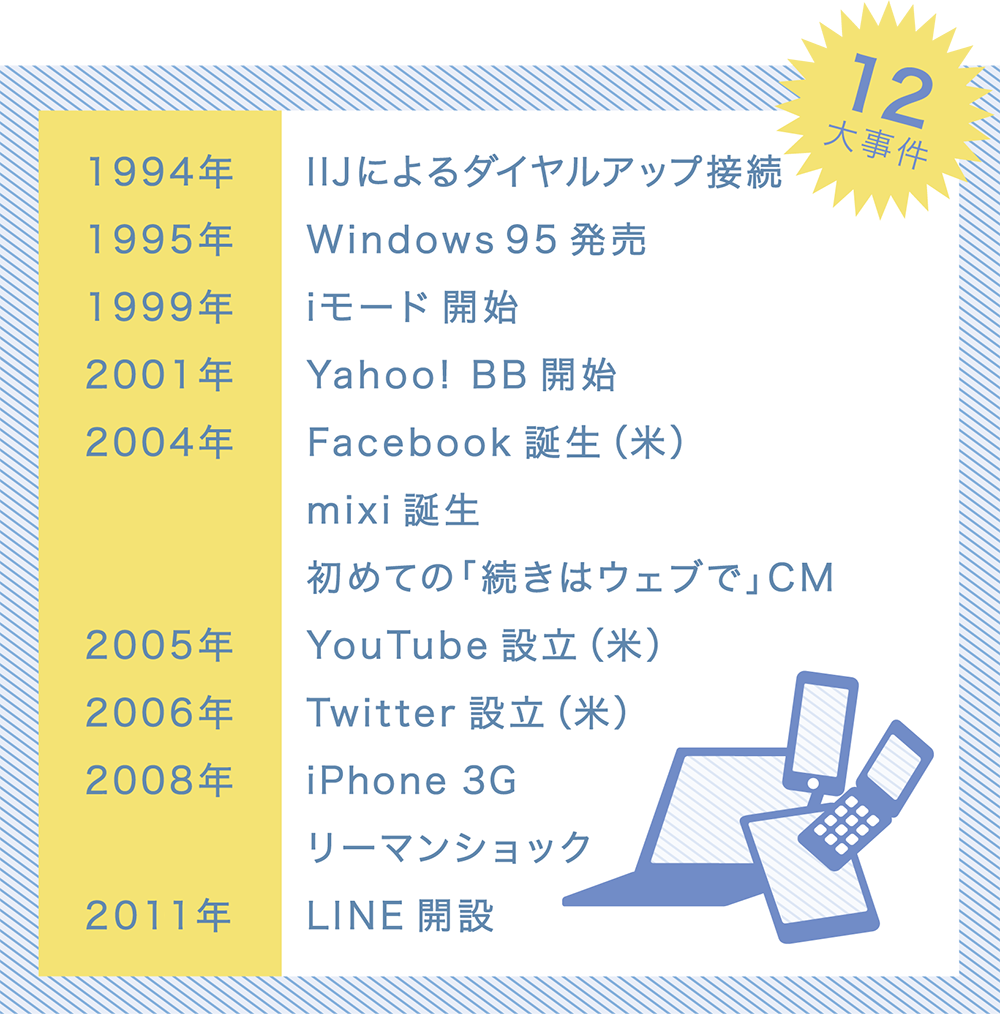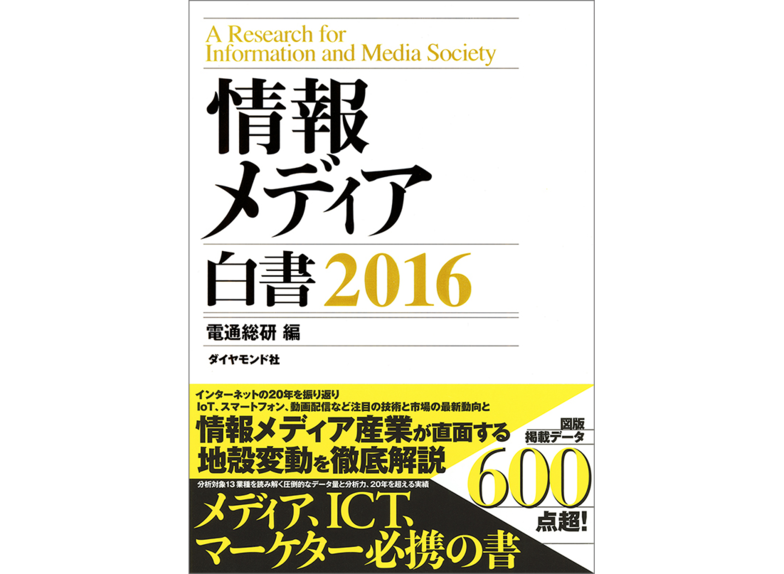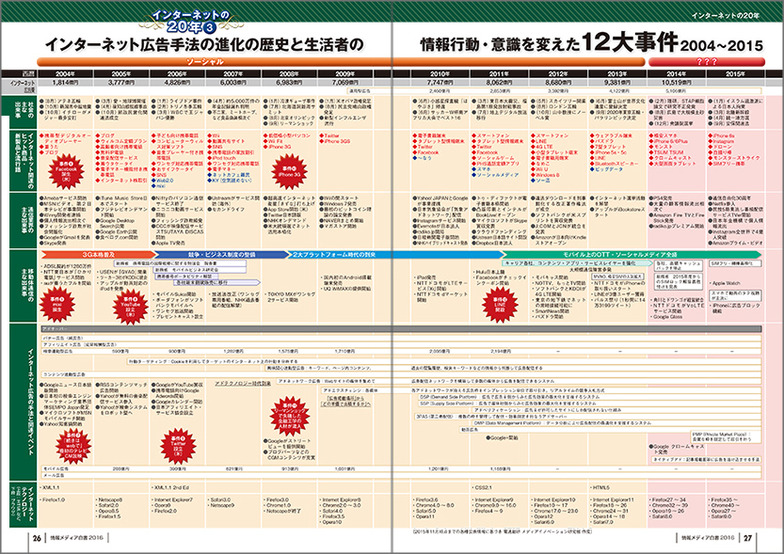The spread of the Internet has dramatically changed how audiences access information. What happened in the 20 years since 1995, often called the dawn of the Internet in Japan? This is compiled based on research and analysis by DENTSU SOKEN INC. Media Innovation Research Department, captured from their unique perspective.
Part 2 focuses on the "Evolution of Advertising Methods" within these 20 years of the Internet. Twelve keywords were selected based on their significant impact on changing consumer behavior, providing an overview by era.
Two symbolic events during this period, which sparked the Internet's widespread adoption among general consumers, were IIJ's introduction of dial-up connections (1994)and the release of Windows 95 (1995). Although communication speeds were low by today's standards, Windows 95's advanced usability enabled access to the world via telephone lines.
By around 1996, various internet sites had proliferated, and consumers began engaging in a new behavior: information searching, which existing media could not provide.
Internet advertising at the time started with a system where "banner ads (display ads)" were submitted to servers owned by media outlets. In other words, just like with other media (newspapers, magazines, radio, TV), advertisers could only place ads on platforms they believed had high affinity with their customers, specifying the duration and other conditions.
For example, when an automobile company advertised a new product, it would purchase ad space on automotive specialty sites where its customers or potential buyers were likely to browse. This era is also referred to as the "blanket placement" period.
From a media planning perspective, targeting was largely based on the judgment and experience of corporate marketers. Around 1996, ad servers emerged to store and deliver ad content. However, a constant risk of supply-demand mismatch existed between advertisers (purchasing ad space) and publishers (offering ad space), leading to the persistent issue of excess ad inventory.
However, from the perspective of creative expression, or advertising presentation, this period also saw the emergence of advanced advertising techniques for the time. These included incorporating GIF animations into static banner ads to achieve dynamic visual effects.
i-mode (1999) enabled email and web browsing on mobile phones, while Yahoo! BB (2001) brought faster, more affordable home internet. Preceding ADSL adoption, 1999 saw i-mode make internet communication possible outside the home. This period marked the shift where email and website browsing became location-independent.
Around 2000, as ADSL rapidly entered households, consumers began enjoying the new added value of unlimited internet access. In other words, setting a cap on the previously metered communication costs laid the foundation for broader internet adoption.
Around this time, advertising methods entered an era of diversification. Affiliate advertising (performance-based advertising), where costs were incurred only for actual results generated by ad placements (such as clicks), along with its related "reward advertising" and "boost advertising," emerged. "Listing advertising" (search-linked advertising), which successfully monetized consumers' search behavior, remains a critically important marketing method even today.
Creatively, internet advertising expressions also began to advance around this time, with full-screen ads using Flash movies, floating ads, and video ads all thriving.

Following 2004, the emergence ofsocial media platforms likeFacebook, mixi, YouTube, and Twitter led to the development of CGM (Consumer Generated Media), where consumers themselves create the content.
Furthermore, as an attempt to cross-promote with existing media, Japan's first " CM with a web continuation " was Nestlé's 2004 AERO chocolate commercial (the earliest confirmed example found via Dentsu Inc. advertising statistics).
This was an epoch-making advertising strategy: after viewers recognized the product from the commercial, they were directed to a website designed to further enhance awareness and spark interest—a tactic that required consumers to search for it themselves. Even today, incorporating a search box into TV commercials is a common creative approach.
has become a very common technique.

The iPhone 3G, released in 2008, can be cited as a device that made search behavior significantly easier compared to existing feature phones. The iPhone 3G dramatically increased consumers' search activity, leading to benefits such as improved accuracy in search-linked advertising, interest-based advertising, and behavioral targeting.
LINE, now used by many consumers, has become an indispensable communication tool, especially among younger demographics. As covered in Part 1 of this series, it also contributed to providing a new information transmission mechanism: communication not reliant on text.
It is said that the 2008 Lehman Shock triggered the influx of professionals, who had previously built wealth using sophisticated financial engineering primarily in the US and UK, into the internet market after losing their jobs. This event also significantly contributed to the industry's boom by initiating a period where the ad tech world became highly engineered and sophisticated.
These professionals provided solutions—broadly defined as ad tech—to address longstanding challenges in the internet industry. These included developing real-time bidding (RTB) systems for ad auctions, automating ad delivery, refining targeting, optimizing ad inventory, and quantifying ad effectiveness. The foundation for programmatic advertising—automated, machine-driven ad transactions—was laid during this period.
One transformative concept in internet advertising by this era was the shift in mindset from "buying ad space" to "buying reach—that is, the number of people who will see the information."

Even this efficiency-focused practice of prioritizing "how many people see it" had room for improvement. Growing dissatisfaction with the lack of visibility into which sites displayed their ads led to a partial reevaluation starting around 2014. This resulted in the emergence of PMP (Private Marketplace) transactions, which provide advertisers with high-quality ad placements. Essentially, it's a system guaranteeing placements on premium sites, excluding those advertisers wish to avoid.
While advertisers must pay a premium for this, it is considered a transaction model with high potential demand. Consequently, the adoption of advertising transactions incorporating this reservation-based advertising concept became more active.
This addition of new value to internet advertising transactions helped propel 2014 into a symbolic year: internet advertising spending surpassed 1 trillion yen, with the programmatic advertising category alone exceeding 500 billion yen.
While no events have significantly altered consumer behavior since 2015, it is certain that unpredictable technologies, services, and products will continue to emerge from the internet world.
The impact of the IoT (Internet of Things) world, where everything is connected, and the world of Industry 4.0, Germany's Fourth Industrial Revolution, on Japan's information media-related industries
While observing these impacts, we must closely monitor the evolving media landscape leading up to the 2020 Tokyo Olympics and Paralympics.
For details, see the book 'Information Media White Paper 2016 '.

The book provides detailed information in a timeline.











